The Secret Life of Einstein
|
He may have been a genius and leading light in the world of physics, but
Einstein was a dismal failure at relationships. He left behind a trail of
broken marriages and affairs in pursuit of his first love - science.
Gareth Huw Davies
"My sweet little witch without you my life is no life," simpered
this century's most colossal intellect, the man who changed our understanding
of space, time and how the universe works, whose ideas led to the development
of TV and the laser. "You absolutely must come to see me. I promise you an
outing the like of which you have never seen."
The year was 1900 and 21-year- old
Albert Einstein was seeking the answer to a
stupendous question: what would it be like to ride a beam of light? But at
that moment he had the more conventional pursuits of a young man in mind.
When fellow student Mileva Maric arrived at the lakeside love nest in Como,
Italy, she found her "dear, naughty little sweet-heart waiting with pounding
heart and open arms". They were both to pay dearly for that weekend of passion.
It might even have delayed his ferociously brilliant
theory
of relativity.
The image we have of Einstein is of a twinkly- eyed,
droopy-moustached old eccentric. But by the time be achieved universal renown,
unknown to an admiring world, he had clocked up two failed marriages, at
least one affair and had fathered an illegitimate child. His recently released
letters reveal a human being not so unlike many lesser mortals. The man who
predicted how the gravitational force of the sun bent a star's a light was
prey to all the normal earthly desires and, by the end of his life, had confessed
himself an emotional failure.
Within weeks of the tryst in Como, Einstein faced the biggest
dilemma of his life. Desperate for work, having ruled himself out of a post
at his old university by his maverick method of learning only what he chose
- in one physics practical he recorded the lowest possible mark - he had
just landed the promise of steady employment in the Swiss patent office in
Bern. Then he heard that Mileva was pregnant.
"When it comes to close relationships I failed twice,disgracefully...marriages are dangerous" |
|
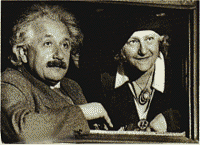 |
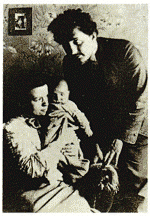 |
| Relative values : Albert Einstein with first wife Mileva and baby son (right) and with second wife and cousin Elsa (above). | |
In 1902 Switzerland, the revelation that Einstein was a father out of wedlock would have cost him the job. He should have heeded his mother. "You'll be in a pretty mess if she has a baby," she warned. The letters show how ruthlessly he hid the indiscretion. Mileva could not even be seen in the same town as him. She went back to her parents and gave birth to a daughter, Lieserl. For a time, Einstein played the doting father, showing a tenderness that he was to jettison in favour of his towering scientific agenda. "I love her," he wrote to Mileva. "Does she cry?"
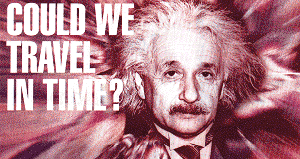 |
| Einstein declared in 1905 that the faster
one moves, the slower time passes. Sounds iffy? In 1971, American scientists
proved his theory by taking an atomic clock (used for its extreme accuracy)
around the world in a plane and comparing their clock with others that remained
on the earth - it had lost time. And in Monday's Horizon (BBC2), one of those
scientists, Professor Jo Hafele, relives the experiment, travelling from
London to Washington on a 747. Bingo! His clock registers 40 billionths of
second less than those earthbound. The rest of Horizon's The Time Lords documentary extrapolates the theory to ask whether time travel is genuinely possible, with contributions from, among others, Stephen Hawking, Carl Sagan and a man who built a negative-energy machine "for fun". The physics of the argument are naturally highly complicated and, during his stopover in London Hafele kindly attempts to explain using cigarette butts and an ashtray to represent aeroplanes and the earth. But lets cut to the crux: is time travel possible? "Send one 20-year-old twin into space he'd have to travel at almost the speed of light, on a trip that lasted ten years, to reach the earthbound twin, who would be 30. The travelling twin would be 21 when he came back, having aged only a year. That's theoretically possible," says Hafele, "but to build the rocket required is not economically possible .It's way off in the future." Suppose Einstein was destined to die in a year. If you sent him off into space and he returned after ten earth years, would he still be alive? Hafele pauses: "Yes. But he'd die as soon as he landed." At least he'd understand the irony. NICK GRIFFITHS |
But he never saw his daughter. Foster parents were found for
Lieserl and she is believed to have died of smallpox as a baby. Robert Schulmann,
of the Boston-based academic group the Einstein Papers Project, recently
travelled to Serbia to try to discover what became of her, but could find
no trace. Two years later, Einstein married Mileva but abandoning Lieserl
had been devastating. From now on he locked away his emotions: "My essence
is what I think, not what I feel."
"He wanted sex without complications," says Schulmann. "His
pursuit of ladies was one where the sense of obligation was at a minimum,
but the pursuit of pleasure was maintained - The pursuit of the greatest
priority - physics - was never in question."
In 1905, aged 26, Einstein scaled the Everest of science when he expounded
his theory of relativity. The Swiss job had been ideal in affording him the
freedom to think, and the answer came to him in a
flash one sunny day as he was out walking with a friend.
As Europe lionised her husband, Mileva
was left increasingly lonely at home. "I only hope fame will not exert a
detrimental influence on his human side," she wrote. I'm starved of love.
I almost believe wicked science is guilty."
"When one thinks seriously day and night one can't engage easily in loving
chatter," responded Einstein. But he, too, paid a huge emotional price. He
hardly saw his two sons.
Mileva named his work as co-respondent in their divorce, but soon there was
another woman Einstein's cousin
Elsa."I love you," he
wrote to her '"I would be so happy to walk a few steps at your side-without
my wife, who is very jealous I treat her as an employee whom I cannot
sack."
Working out the theory of gravity took six years
and brought him near to death from nervous exhaustion. It wasn't until 1917
that his predictions were verified and he achieved world fame, winning the
Nobel prize for physics four years
later. In 1919 he divorced Mileva and married Elsa, who had helped nurse
him back to health but, though she provided him with loving support, he
subsequently had an affair with a younger woman.
Despite his academic success, Einstein's last letters reveal
his sense of emotional failure. "I can love humanity, but when it comes to
close relationships, I'm a horse for single harness. I failed twice, rather
disgracefully." As for marriage: "An unsuccessful attempt to make something
lasting out of an incident. All marriages are dangerous."
The world knew nothing of this as Einstein lived in placid exile in the USA
after leaving Germany in 1933. He died in 1955. His personal papers were
not released for academic study until the late eighties. This week's
Horizon: Einstein is the
first complete study of his life, taking in that hitherto unpublished
material.
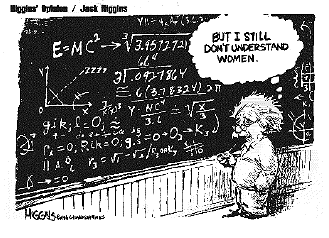 |
"We don't intend scurrilously to topple a great figure," says
co-producer Peter Jones "I strongly believe you have to understand the human
being first to understand the scientist. Periods of tremendous concentration
exclude other things, and this is true of many great intellects. Could Einstein
have had a settled emotional life and been a great scientist? We leave that
to the viewer to decide"
The idiots' guide to Einstein's special theory of relativity |
|
|
 |
|
|
Stop the clocks
Relativity was not just Einstein's monster. P D
Smith enjoys an absorbing study which rewrites the equation

Einstein's Clocks, |
NOWADAYS WE take time too much for granted.
In 1880, a public clock in Geneva needed three faces to show the time in
Geneva, Paris and Bern. The challenge for scientists and engineers was to
find a reliable way of standardising time across cities and countries by
connecting clocks to a central "mother clock". In Paris an ingenious city-wide
system of clocks was regulated by compressed air piped beneath pavements.
Heath Robinson would have been proud of it, but by the end of the century
electricity offered an easier way of undying time. According to the historian
of science Peter Galison, synchronising clocks remained an urgent issue in
the 20th century: "Time coordination in the Central Europe of 1902-05 was
not merely an arcane thought experiment; rather; it critically concerned
the clock industry the military and the railroads," as well as being a symbol
"of the interconnected, sped-up world of modernity."
It was this practical problem that provided Albert Einstein with a crucial
clue to the complexities of relativity. In May 1905, after a day of intense
discussion with his favourite "sounding-board" Michele Besso, Einstein finally
found the answer he had spent nine years searching for. The key lay in "an
analysis of the concept of time". Pointing out two far-flung clock towers,
Einstein explained: "Time cannot be absolutely defined, and there is an
inseparable relation between time and signal velocity."
Galison's book explores notions of simultaneity in order to explain the origins
of relativity. As well as Einstein, he brings a less
familiar figure into the relativity equation: Henri
Poincaré, the extraordinary French mathematician, philosopher
and physicist "who produced, quite independently of Einstein, a detailed
mathematical physics incorporating the relativity principle". From the 1890s
Poincaré worked at the Bureau of Longitude.
There the new global network of telegraph cables was used to map the globe
by sending time signals to the four corners of the world. But time is a harsh
master and Poincaré has been relegated to a footnote in the history
of relativity By bringing nim out of Einstein's shadow, Galison argues that
Einstein's theory was part of a widespread material and intellectual concern
with the cultures of time. One of the far-reaching implications of relativity
is that our sense of simultaneity is an illusion.
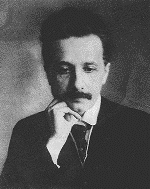 |
| Einstein: universal timekeeping led to the theory of relativity |
There is no such thing as a universal
"now".
Einstein rejected Newton's notion of a "universally audible tick-tock". In
his work as a patent officer in 1905, Einstein examined proposals for
cutting-edge electrotechnology, including synchronised clocks.
According to Galison, to talk about simultaneity at the beginning of the
20th century was to ask how to coordinate clocks. For both Einstein and Poincare
the answer was to use an electric signal, and deduct the time taken for the
signal to travel between the clocks. It was an idea with "breathtkang
consequences for concepts of time and space, for the new relativity theory
for modern physics" and for "our very model of secure scientific knowledge".
The problem of coordinating clocks helped Einstein see that Newton's absolute
time was wrong: his theological concept had no place in a technological
and secular age. Galison is right to argue that the history of relativity
is about more than one man and that it's an idea rooted in practical concerns,
in time-keeping and mapmaking, as well as the higher
abstractions of philosophy and physics. He makes few concessions to the
non-specialist reader; but this impressive study is absorbing, original and
full of insights into the revolutionaries of time.
PD Smith's illustrated biography of Einstein is published by
Hans.
[Indepedent Magazine prior to 27Sep 2003]
